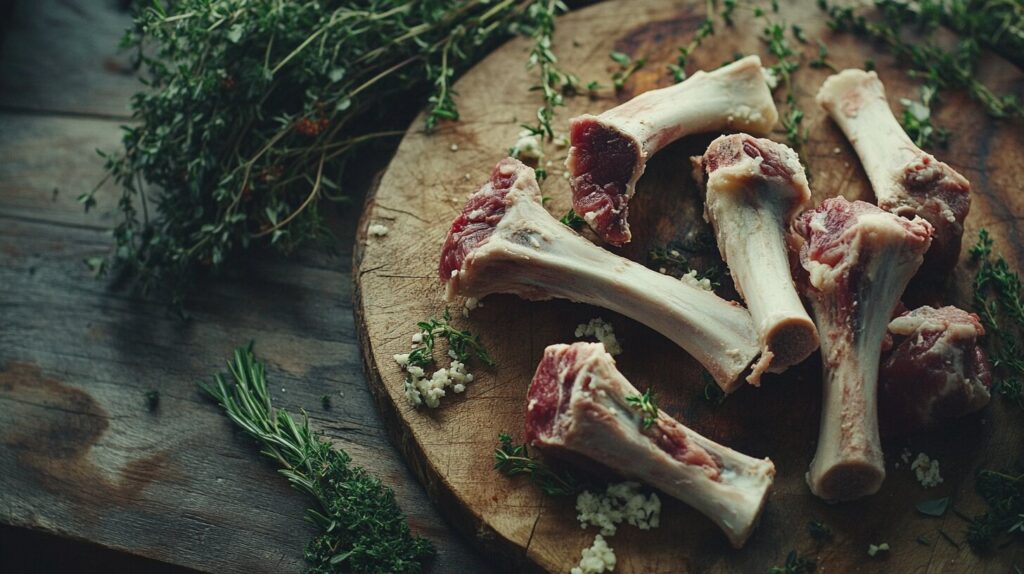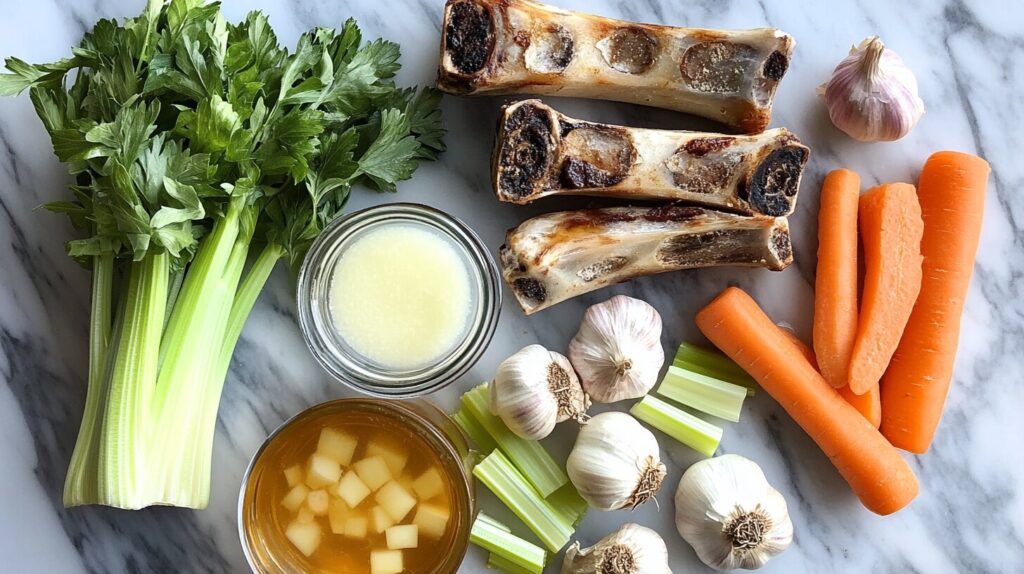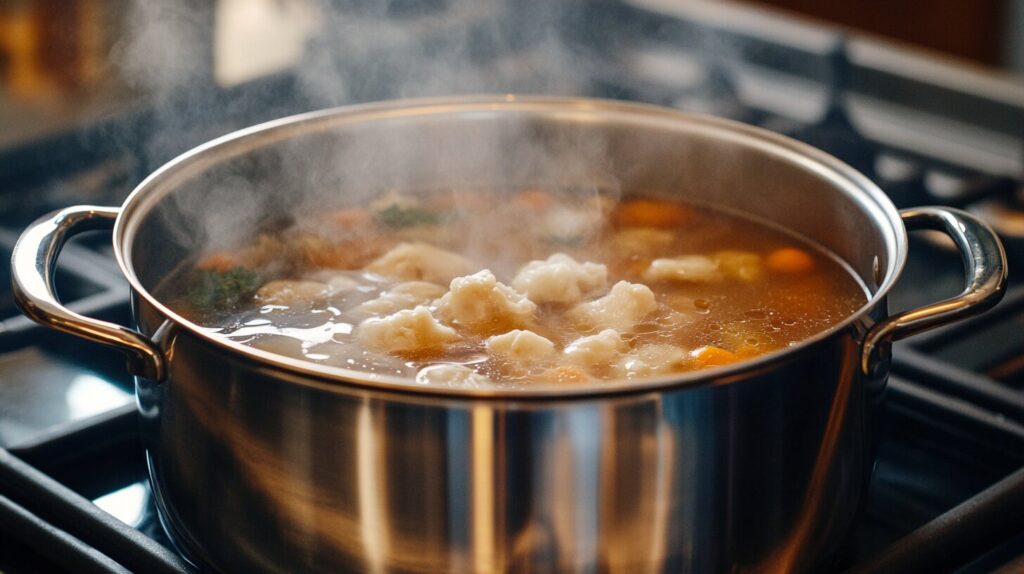Soup bones might seem like a humble kitchen staple, but they hold the secret to some of the most flavorful, nourishing meals. If you’ve ever savored a rich, hearty broth and wondered how to make it yourself, you’re in the right place! Let’s dive into the wonderful world of soup bones and uncover why they deserve a spot in your cooking repertoire. 🥣
Table of Contents
🥘 What Are Soup Bones?
Soup bones are exactly what they sound like: bones used to make soups and broths. These are usually leftover bones from cuts of meat like beef, chicken, or even turkey. They often contain some meat, marrow, and cartilage, which gives broths their deep flavor and nutritious quality.
The magic of soup bones lies in the slow cooking process. As they simmer, the bones release essential nutrients, minerals, and collagen, turning simple water into a rich, savory liquid gold. Whether you’re making bone broth, stew, or a hearty soup, soup bones are the foundation of it all.
🦴 Types of Soup Bones and Their Uses
Soup bones aren’t one-size-fits-all. Depending on the type of meat and the dish you want to create, different bones offer different benefits. Let’s explore the most popular types.
🥩 Beef Soup Bones
What are they?
Beef soup bones typically come from the leg, neck, or ribs. These bones often contain marrow, which adds an incredibly rich, beefy flavor to broths and stews.

Best uses:
- Classic beef bone broth
- Hearty vegetable soups
- Slow-cooked stews
Why use them?
Beef soup bones are packed with marrow and gelatin, which not only makes your broth flavorful but also incredibly nutritious. They’re perfect for recipes that need a robust, deep flavor.
“A good beef bone broth is like a warm hug in a bowl — comforting, nourishing, and full of flavor.”
🐓 Chicken Soup Bones
What are they?
Chicken soup bones come from the carcass, neck, or wings. They’re lighter than beef bones but create a broth that’s just as satisfying.
Best uses:
- Chicken noodle soup
- Light bone broth
- Comforting stews
Why use them?
Chicken bones are fantastic for creating a lighter, more delicate broth. Perfect when you’re feeling under the weather or just need a simple, soothing soup.
🦃 Turkey Soup Bones
What are they?
Turkey soup bones, often leftover from Thanksgiving or holiday meals, are excellent for creating rich, savory broths.
Best uses:
- Turkey noodle soup
- Holiday-inspired bone broth
- Hearty stews
Why use them?
Turkey bones have a more pronounced flavor compared to chicken bones. They’re perfect for creating larger batches of broth due to their size.
🍲 Why Are Soup Bones Important for Cooking?
Soup bones aren’t just about taste; they bring a world of benefits to your cooking. Here’s why every home chef should use them.
- Flavor Boost: Slow-cooked bones infuse broths with a deep, satisfying taste.
- Nutrient-Rich: Packed with collagen, minerals, and amino acids that are great for your health.
- Cost-Effective: Often inexpensive and perfect for making use of leftover meat cuts.
- Versatility: Suitable for a wide range of recipes, from broths to sauces.
“The secret to a restaurant-quality soup? A good set of soup bones. No shortcuts!”
🥦 Nutritional Benefits of Soup Bones
When you simmer soup bones, you’re not just getting flavor — you’re extracting powerful nutrients. Let’s break down the key benefits.
- Collagen and Gelatin: These help improve skin, hair, and joint health.
- Calcium and Magnesium: Essential for strong bones and overall well-being.
- Amino Acids: Boost your immune system and promote gut health.
- Marrow: Full of healthy fats, vitamins, and minerals.
A homemade bone broth is like a multi-vitamin in liquid form. So, the next time you’re sipping on your soup, know you’re giving your body a major boost!
🧠 Did You Know? Bone broth has been used for centuries as a natural remedy for colds, joint pain, and digestive issues.
🛒 How to Choose the Best Soup Bones
Not all soup bones are created equal! Here’s how to find the best ones for your recipes.
👀 Quality Indicators to Look For
- Freshness: Fresh bones should look clean and moist, not dry or discolored.
- Marrow Content: Look for bones with visible marrow (that soft, fatty center).
- Meatiness: A little extra meat on the bones can add more flavor.
- Color: Bones should be bright red (for beef) or pale (for chicken or turkey).
🏪 Where to Buy High-Quality Soup Bones
You can find soup bones at:
- Butcher Shops: A butcher will often give you fresh, high-quality bones.
- Grocery Stores: Many stores now sell pre-packaged soup bones.
- Farmers’ Markets: Great for finding organic or grass-fed bones.
- Online Retailers: Many sites offer specialty bones for delivery.
Tip: Ask your butcher for “knuckle bones” or “marrow bones” for the richest broths.
🔥 How to Prepare Soup Bones for Cooking
Before you start cooking, you need to prep those bones properly. Here’s how to do it right.

🍖 Roasting Soup Bones for Extra Flavor
Roasting your bones before simmering can give your broth a deep, caramelized flavor. Here’s how:
- Preheat your oven to 400°F (200°C).
- Place the bones on a baking sheet.
- Roast for 20-30 minutes until they’re browned.
Roasting unlocks a rich, savory taste that takes your broth to the next level.
💦 Cleaning and Blanching Soup Bones
Blanching helps remove impurities that can make your broth cloudy.
- Place bones in a pot and cover with cold water.
- Bring to a boil and simmer for 10 minutes.
- Drain and Rinse thoroughly under cold water.
This quick step keeps your broth clean and clear.
🥄 And that’s just the beginning of your soup bone journey! We’ve covered the basics, but there’s still so much more to explore — from recipes to solving common cooking problems.
🍲 Popular Recipes Using Soup Bones
Now that you know the basics, it’s time to put those soup bones to work in the kitchen! Whether you’re craving a warm bowl of beef bone broth or a nourishing chicken soup, these recipes will take your culinary skills to the next level.
🥣 Classic Beef Bone Broth Recipe
Nothing beats a steaming cup of beef bone broth when you’re looking for comfort and nutrition. This recipe will guide you step-by-step to achieve a deep, rich flavor.
Ingredients:
- 2-3 pounds of beef soup bones (knuckle bones, marrow bones, or shank bones)
- 2 carrots, chopped
- 2 celery stalks, chopped
- 1 large onion, quartered
- 4 cloves of garlic, smashed
- 2 tablespoons apple cider vinegar (helps extract minerals)
- 2 bay leaves
- 1 tablespoon peppercorns
- Fresh herbs (thyme, rosemary, or parsley)
- 10-12 cups water

Instructions:
- Roast the Bones: Preheat your oven to 400°F (200°C). Place the bones on a baking sheet and roast for 30-40 minutes until nicely browned. This step intensifies the flavor.
- Blanch the Bones: Place the roasted bones in a large pot. Cover with cold water and bring to a boil. Simmer for 10 minutes, then drain and rinse.
- Simmer the Broth: Return the bones to the pot. Add carrots, celery, onion, garlic, apple cider vinegar, bay leaves, and peppercorns. Cover with 10-12 cups of water.
- Cook Slowly: Bring to a gentle boil, then reduce the heat and simmer for at least 12 hours (up to 24 hours for maximum nutrient extraction). Skim off any foam or impurities that rise to the surface.
- Strain and Serve: Once done, strain the broth through a fine mesh sieve. Discard the solids and season with salt to taste. Enjoy warm or store in jars for later use.
Tip: You can freeze the broth in ice cube trays for easy, portioned servings!
🍜 Comforting Chicken Bone Broth
Chicken bone broth is a classic remedy for colds, fatigue, and those gloomy days when you need a pick-me-up. Here’s how to make it at home.
Ingredients:
- 1 whole chicken carcass or 2 pounds of chicken soup bones (necks, wings, or feet)
- 2 carrots, chopped
- 2 celery stalks, chopped
- 1 large onion, quartered
- 4 cloves of garlic, smashed
- 2 tablespoons apple cider vinegar
- 2 bay leaves
- 1 tablespoon peppercorns
- Fresh herbs (parsley, thyme)
- 8-10 cups water
Instructions:
- Prepare the Bones: Place the chicken bones in a large pot.
- Add Vegetables: Toss in the carrots, celery, onion, and garlic.
- Add Water and Vinegar: Pour in 8-10 cups of water and add the apple cider vinegar.
- Simmer Gently: Bring to a boil, reduce the heat, and simmer for 6-8 hours. Skim any foam off the top occasionally.
- Strain and Season: Strain the broth, discard the solids, and season with salt and herbs to taste.
“Chicken soup is the ultimate comfort food — nourishing both the body and the soul.”
🥕 Vegetable Soup with Beef Bones
A hearty vegetable soup with the richness of beef bones is a meal that’s both satisfying and nutritious.
Ingredients:
- 2 pounds of beef soup bones
- 2 carrots, sliced
- 2 celery stalks, sliced
- 1 large onion, diced
- 2 cloves garlic, minced
- 2 potatoes, cubed
- 1 can diced tomatoes
- 1 teaspoon thyme
- 1 teaspoon rosemary
- 8 cups water
- Salt and pepper to taste
Instructions:
- Roast the Bones: Roast the beef bones at 400°F (200°C) for 30 minutes to enhance the flavor.
- Simmer the Broth: Place the bones in a pot with 8 cups of water. Simmer for 8 hours, then strain the broth.
- Cook the Vegetables: In a large pot, sauté the onions and garlic. Add the carrots, celery, potatoes, and diced tomatoes.
- Combine and Season: Pour the strained beef broth into the pot. Add thyme, rosemary, salt, and pepper.
- Simmer and Serve: Cook for 30 minutes until the vegetables are tender. Enjoy with a slice of crusty bread!
🛠️ Common Problems When Cooking with Soup Bones
Cooking with soup bones can sometimes be tricky. Let’s tackle the most common problems and how to solve them.
🌫️ Cloudy Broth: Causes and Fixes
Why does it happen?
Cloudy broth usually happens when the broth boils too vigorously or the bones weren’t blanched properly.
How to fix it:
- Blanch the Bones: Always blanch bones for 10 minutes before simmering.
- Gentle Simmer: Keep the heat low to avoid boiling.
- Skim Frequently: Remove any foam or impurities that rise to the surface.
🥱 Lack of Flavor: Tips to Enhance Taste
Why does it happen?
A weak flavor can result from using too few bones or not cooking the broth long enough.
How to fix it:
- Roast the Bones: Roasting intensifies flavor.
- Use Aromatics: Add onions, garlic, carrots, and herbs.
- Longer Cooking Time: Simmer for at least 6-12 hours for beef bones and 4-6 hours for chicken bones.
❄️ How to Store and Freeze Soup Bones
Storing soup bones properly ensures they’re ready when you need them.
- Refrigeration: Store fresh bones in the fridge for up to 3 days.
- Freezing: Wrap bones tightly and freeze for up to 6 months. Label with the date for easy tracking.
- Broth Storage: Freeze bone broth in jars or ice cube trays for quick, portioned servings.
🥄 Using Leftover Soup Bones
Don’t throw those bones away just yet! Here are a few ways to reuse them:
- Double Broth: Use leftover bones to make a second, lighter batch of broth.
- Pet Treats: Give your pets a bone to gnaw on (make sure it’s safe and not brittle).
- Composting: Once bones are fully spent, compost them for a nutrient-rich soil additive.
🌿 Health Benefits of Bone Broth
Soup bones don’t just create delicious broths — they offer a treasure trove of health benefits! Bone broth, made by simmering bones for hours, is packed with nutrients that support overall wellness. Let’s break down the key health benefits of incorporating bone broth into your diet.

💪 Joint Health and Mobility
One of the standout benefits of bone broth is its high collagen and gelatin content. When simmered, these proteins are released from the bones and converted into gelatin, which helps improve joint health and reduce inflammation.
- Collagen is the building block of cartilage, which cushions your joints.
- Gelatin helps keep joints flexible and may alleviate symptoms of arthritis.
Regularly sipping on bone broth can help maintain joint mobility and reduce stiffness. If you’re an athlete or just experience occasional joint pain, bone broth might be your natural remedy.
“Bone broth is like a natural lubricant for your joints. It keeps everything moving smoothly!”
😊 Gut Health and Digestion
Bone broth is a superstar for digestive health. The gelatin in bone broth helps to repair and strengthen the lining of your gut, which is crucial for preventing leaky gut syndrome.
- Amino acids like glutamine support a healthy gut lining.
- Gelatin aids digestion by binding to water in the digestive tract, helping food move smoothly through your system.
If you struggle with bloating, indigestion, or IBS, incorporating bone broth into your diet may help calm your gut.
🧠 Mental Health and Sleep
Did you know bone broth can help with mood and sleep quality? It contains amino acids like glycine, which have calming effects on the brain.
- Glycine helps reduce anxiety, improve sleep quality, and promote a sense of relaxation.
- Sipping warm bone broth before bed can help you wind down and get a good night’s sleep.
Think of bone broth as a cozy blanket for your nervous system. It’s a small comfort that can make a big difference in your mental well-being.
🍵 Myths and Misconceptions About Soup Bones
There are plenty of myths surrounding soup bones and bone broth. Let’s set the record straight and debunk some common misconceptions.
🚫 Myth 1: Bone Broth Is Just a Trend
Reality: Bone broth has been around for centuries! Traditional cultures have always simmered bones to extract nutrients and flavor. This isn’t a new fad — it’s a time-tested cooking technique.
🚫 Myth 2: Only Expensive Bones Work
Reality: You don’t need to spend a fortune on fancy bones. Even simple, inexpensive soup bones can create a rich, flavorful broth. It’s all about the preparation and slow cooking process.
🚫 H3: Myth 3: Bone Broth Is Too Complicated to Make
Reality: Making bone broth is incredibly simple! With just a few ingredients and a little patience, you can create a nutritious broth at home. No special skills required.
“Bone broth is one of the easiest, most rewarding things you can make in the kitchen. Just simmer and savor!”
❓ Frequently Asked Questions About Soup Bones
Let’s tackle some of the most common questions people have about soup bones and bone broth.
🔄 Can Soup Bones Be Reused?
Yes, you can reuse soup bones to make a second, lighter broth. After your first batch, the bones still contain some nutrients. Just add fresh water and vegetables and simmer again. The second batch won’t be as rich, but it’s still delicious and nutritious.
⏳ How Long Should You Cook Soup Bones?
- Beef Bones: 12-24 hours for maximum nutrient extraction.
- Chicken Bones: 6-8 hours for a rich, flavorful broth.
- Turkey Bones: 8-12 hours for a hearty broth.
The longer you simmer, the more nutrients and collagen you’ll extract.
🐶 Are Soup Bones Safe for Pets?
Yes, but with caution. Never give pets cooked bones, as they can splinter and cause injury. Instead, use raw bones or specially prepared bone broths for pets. Always consult your vet before introducing bones into your pet’s diet.
🍲 Can You Add Other Ingredients to Bone Broth?
Absolutely! Enhance your bone broth with herbs, spices, and vegetables like:
- Garlic for flavor and immune support.
- Ginger for anti-inflammatory benefits.
- Parsley for a fresh finish.
Feel free to customize your broth to suit your taste and health needs.
🧊 How Should You Store Bone Broth?
- Refrigerate: Store in the fridge for up to 5 days.
- Freeze: Freeze in jars or ice cube trays for up to 6 months.
Remember to leave space in jars for expansion when freezing!
🏁 Conclusion: The Timeless Value of Soup Bones
Soup bones are the unsung heroes of the kitchen, offering incredible flavor, nutrition, and versatility. Whether you’re simmering a classic beef bone broth, preparing a comforting chicken soup, or tackling a new recipe, soup bones provide a solid foundation for delicious, nourishing meals.
From promoting joint health to supporting gut function and providing a sense of comfort, the benefits of soup bones extend far beyond the pot. And the best part? They’re cost-effective, easy to prepare, and a perfect way to make the most of every part of your food.
So, the next time you’re cooking, don’t overlook those bones! Embrace the tradition, savor the flavor, and let soup bones elevate your kitchen creations to new heights. 🥣✨
🌟 Explore More Hearty Recipes and Guides
Love learning about soup bones and bone broths? There’s so much more to discover! If you want to dive deeper into delicious and comforting dishes, explore our Ultimate Guide to the Perfect Beef Tips Recipe for mastering tender beef dishes. Need tips for differentiating cuts of meat? Check out Stew Meat vs. Beef Tips: Differences and Uses to boost your cooking knowledge. And if you’re craving a cozy, home-cooked meal, don’t miss our Ultimate Chicken Dumpling Soup Recipe — a perfect bowl of comfort! 🍲✨
These guides will help you become a kitchen pro in no time! 🥄😊
